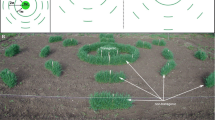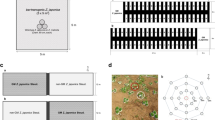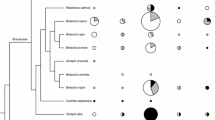Abstract
The objective of this study was to evaluate pollen dispersal inBrassica napus (oilseed rape). The selectable marker, used to follow pollen movement, was a dominant transgene (bar) conferring resistance to the herbicide glufosinate-ammonium. Transgenic and non-transgenic plants of the cultivar Westar were planted in a 1.1 ha field trial, with the transgenic plants in a 9 m diameter circle at the centre, surrounded by non-transgenic plants to a distance of at least 47 m in all directions. A 1 m circle of non-transgenic plants was sown in the centre of the transgenic area to allow estimation of the level of pollen dispersal when plants were in close contact. Honeybee hives were placed at the trial site to optimize the opportunity for cross-pollination. During the flowering period, regular observations were made of the number of plants flowering and the number and type of insects present in 60 1 m2 areas. These areas were located uniformly around the plot at distances of 1, 3, 6, 12, 24, 36 and 47 m from the edge of the 9 m circle of transgenic plants. Seed samples were harvested from each of the 7 distances so that approximately 20% of the circumference of the plot was sampled at each distance. The centre non-transgenic circle was also sampled. Plants were grown from the seed samples and sprayed with glufosinate to estimate the frequency of pollen dispersal at each distance. In order to screen enough samples to detect low frequency cross-pollination events, seed samples were tested in the greenhouse and on a larger scale in the field. Results were confirmed by testing progeny for glufosinate resistance and by Southern blot analysis. The estimated percentage of pollen dispersal in the non-transgenic centre circle was 4.8%. The frequency was estimated to be 1.5% at a distance of 1 m and 0.4% at 3 m. The frequency decreased sharply to 0.02% at 12 m and was only 0.00033% at 47 m. No obvious directional effects were detected that could be ascribed to wind or insect activity.
Similar content being viewed by others
References
Alford, D.V. (1978)The Life of the Bumblebee. pp. 36–43. London: Davis-Poynter.
Bateman, A.J. (1947) Contamination of seed crops I. insect pollination.J. Genet 48, 257–75.
Crane, M.B. and Mather, K. (1943) The natural cross-pollination of crop plants with particular reference to the radish.Ann. Appl. Biol. 30, 301–8.
Eckert, J.E. (1933) The flight range of the honeybee.J. Agric. Res. 47, 257–85.
Free, J.B. and Nuttall, P.M. (1968) The pollination of oilseed rape (Brassica napus) and the behaviour of bees on the crop.J. Agric. Sci. Camb. 71, 91–4.
Gary, N.E. (1975) Activities and behavior of honey bees. In Dadant and Sons eds,The Hive and the Honey Bee, pp. 185–264. Hamilton, Illinois, USA: Dadant & Sons.
Hühn, M., and Rakow, G. (1979) Einige experimentelle Ergebnisse zur Fremdfruchtungsrate bei Winterraps (Brassica napus oleifera) in Abhängigkeit von Sorte und Abastand. Z.Pflanzenzüchtg. 83, 289–307.
Klassen, A.J., Downey, R.K. and Capcara, J.J. (1987) Westar summer rape.Can. J. Plant. Sci. 67, 491–3.
Langridge, D.F. and Goodman, R.D. (1982) Honeybee pollination of oilseed rape, cultivar Midas.Australian J. Expt. Agric. Anim. Husb. 22, 124–6.
Martin, E.C. (1975) The use of bees for crop pollination. In Dadant and Sons eds,The Hive and the Honey Bee, pp. 579–614. Hamilton, Illinois: Dadant & Sons.
McCartney, H.A. and Lacey, M.E. (1991) Wind dispersal of pollen from crops of oilseed rape (Brassica napus L.).J. Aerosol. Sci. 22, 467–77.
Mesquida, J. and Renard, M. (1982) Étude de la dispersion du pollen par le vent et de l'importance de la pollinisation anémophile chez le colza (Brassica napus L., var.oleifera Metzger).Apidologie 13, 353–66.
Olsson, G. (1952) Undersökning av graden av korsbefruktning hos vitsenap och raps.Sveriges Utsädesförenings Tidskrift 62, 311–22.
Olsson, G. (1955) Vindpollinering hos korsblomstriga oljeväxter.Sveriges Utsädesförenings Tidskrift 65, 418–22.
Persson, B. (1956) Undersökningar rörande intek pollinerade kutturväxter III. Korbefruktingens betydelse och omfattning hos raps (Brassica napus L.) speciellt med avseende på binas insats.Statens. Vaxiskyddsanst. Medd. 70, 1–36.
Rakow, G. and Woods, D.L. (1987) Outcrossing in rape and mustard under Saskatchewan prairie conditions.Can. J. Plant Sci. 67, 147–51.
Ribbands, C.R. (1953)The Behaviour and Social Life of Honeybees. London: Bee Research Association Ltd.
Sambrook, J., Fritsch, E.F. and Maniatis, T. (1989)Molecular Cloning: a Laboratory Manual. 2nd edition Cold Spring Harbor, New York: Cold Spring Harbor Laboratory Press.
Stringham, G.R. and Downey, R.K. (1982) Effectiveness of isolation distances in seed production of rapeseed (Brassica napus).Agron. Abstr. pp. 136–7.
Thompson, C.J., Movva, N.R., Tizard, R., Crameri, R., Davies, J.E., Lauwereys, M. and Botterman, J. (1987) Characterization of the herbicide-resistance genebar fromStreptomyces hygroscopicus.EMBO J. 6, 2519–23.
Williams, I.H. (1978) The pollination requirements of swede rape (Brassica napus L.) and of turnip rape (Brassica campestris L.).J. Agric. Sci. Camb. 91, 343–8.
Williams, I.H. (1984) The concentrations of air-borne rape pollen over a crop of oil-seed rape (Brassica napus L.).J. Agric. Sci. Camb. 103, 353–7.
Author information
Authors and Affiliations
Rights and permissions
About this article
Cite this article
Scheffler, J.A., Parkinson, R. & Dale, P.J. Frequency and distance of pollen dispersal from transgenic oilseed rape (Brassica napus). Transgenic Research 2, 356–364 (1993). https://doi.org/10.1007/BF01976177
Received:
Revised:
Accepted:
Issue Date:
DOI: https://doi.org/10.1007/BF01976177




